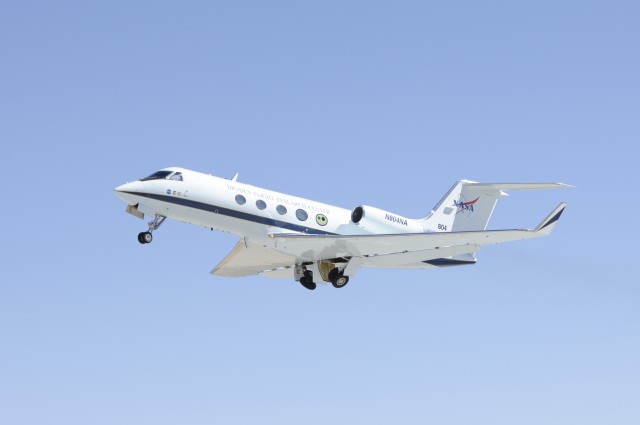Right Now
NASA Successfully Tests New Flexible Airplane Wings
NASA has successfully completed the first test flights for a new airplane technology: a wing that can change shape mid-flight. The project team has already conducted 22 test flights in the last six months with the experimental Adaptive Compliant Trailing Edge (ACTE) wing surface, and so far the results have been promising.
"We are thrilled to have accomplished all of our flight test goals without encountering any significant technical issues," said Air Force Research Laboratory (AFRL) program manager Pete Flick.
The morphing wing technology was fitted to a Gulfstream III airplane. The flexible wings can rotate -2 degrees one way and up to 30 degrees in the other direction. "Servos and actuators inside the flexible shell of the aircraft pull strings that then contort the wings’ surface," according to Popular Science. This increases or reduces the drag of air flowing over it.
The technology has the potential to take aviation to new heights. The adaptive wing significantly increases the fuel economy of the airplanes and thus may decrease the amount of fuel used by as much as 12%. Air travel currently contributes a large amount of pollution to the atmosphere, so this advancement is good news for the environment.
"This is the first of eight large-scale integrated technology demonstrations ERA is finishing up this year that are designed to reduce the impact of aviation on the environment," said Fay Collier, project manager for ERA (Environmentally Responsible Aviation).
People living under air-traffic hotspots can also rejoice: Where old planes with rigid wings have fewer options to reduce drag and as a result are rather noisy, these new sleek wings minimize drag, making them slightly quieter.
In the future, this technology may be integrated into new plane designs and even retrofitted into existing planes. This is very exciting for the future of flight technology, but more tests are needed before we start seeing these wings on commercial aircrafts.
NASA has successfully completed the first test flights for a new airplane technology: a wing that can change shape mid-flight. The project team has already conducted 22 test flights in the last six months with the experimental Adaptive Compliant Trailing Edge (ACTE) wing surface, and so far the results have been promising.
"We are thrilled to have accomplished all of our flight test goals without encountering any significant technical issues," said Air Force Research Laboratory (AFRL) program manager Pete Flick.
The morphing wing technology was fitted to a Gulfstream III airplane. The flexible wings can rotate -2 degrees one way and up to 30 degrees in the other direction. "Servos and actuators inside the flexible shell of the aircraft pull strings that then contort the wings’ surface," according to Popular Science. This increases or reduces the drag of air flowing over it.
The technology has the potential to take aviation to new heights. The adaptive wing significantly increases the fuel economy of the airplanes and thus may decrease the amount of fuel used by as much as 12%. Air travel currently contributes a large amount of pollution to the atmosphere, so this advancement is good news for the environment.
"This is the first of eight large-scale integrated technology demonstrations ERA is finishing up this year that are designed to reduce the impact of aviation on the environment," said Fay Collier, project manager for ERA (Environmentally Responsible Aviation).
People living under air-traffic hotspots can also rejoice: Where old planes with rigid wings have fewer options to reduce drag and as a result are rather noisy, these new sleek wings minimize drag, making them slightly quieter.
In the future, this technology may be integrated into new plane designs and even retrofitted into existing planes. This is very exciting for the future of flight technology, but more tests are needed before we start seeing these wings on commercial aircrafts.
-
 NASA Successfully Tests New Flexible Airplane Wings
NASA Successfully Tests New Flexible Airplane Wings
NASA has successfully completed the first test flights for a new airplane technology: a wing that can change shape mid-flight. The project team has already conducted 22 test flights in the last six months with the experimental Adaptive Compliant Trailing Edge (ACTE) wing surface, and so far the results have been promising.
Sign In to leave a comment
More Posts

PwrCor s PWCO Chief Execu...
13 Apr 2020

Why some of us our shy and ...
5 Jun 2019

Scientists reveal secrets o...
5 Jun 2019

Robert Downey Jrh
5 Jun 2019

Report This Post
Please complete the following requested information to flag this post and report abuse, or offensive content. Your report will be reviewed within 24 hours. We will take appropriate action as described in Findit terms of use.
Thank you. Your abuse report was sent.



















